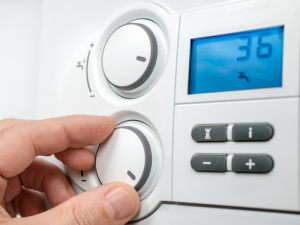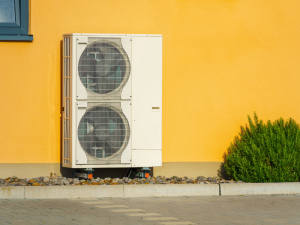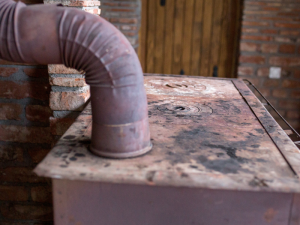When it comes to the start of winter, the last thing that anyone wants to deal with is the struggle to keep everyone warm, especially during the holidays. One of the most important considerations you can make is how you want to heat your home. While furnaces are a great and popular option, are there any other alternatives that work as well?
Just like furnaces, many homeowners have turned to gas fireplaces to heat their homes. Both are great options to invest in, but it often brings up the differences between a gas fireplace vs furnace and which are the better options for you as a homeowner to get.
If you’re looking to replace an old heating system or want to install one of them in your new home, we’ve got everything you need to know about the pros and cons of both furnaces and gas fireplaces.
Once you’ve made a choice, you can call our talented team at Clover Contracting for reliable service. We do our best to make sure that you aren’t left in the cold and are ready to help as soon as possible.
How Do Gas Fireplaces Work?
As technology developed and many more safety measures were put into heating systems, gas-powered fireplaces soon became a great alternative option to the traditional wood fireplace. Though both are still available for purchase and installation today, gas fireplaces became a great middle ground to provide safe and effective heating when compared to other styles.
With how a gas fireplace works, an electrical supply works with its ignition system to create a spark. This spark is then used along with a pilot flame to light the fireplace’s incoming gas and any excess is vented out through tubes built into the wall behind the fireplace.
These same tubes also allow air to be brought to maximize the amount of heat created for heating. To keep the flames burning, more gas is brought in and lit. The result is the “roaring” flames that you see in many standard fireplaces.
How Do Furnaces Work?
When a furnace turns on to heat a home, it starts by drawing in gas from a storage tank or the gas supply line your home has; this is one of the similarities between a furnace vs a fireplace (that’s gas powered).
Once enough is brought in, the furnace’s burners light the gas via a pilot light and draw in cold air through the ducts. The air is heated by the burning gas before getting blown through the vents for heating. More cold air is brought in and heated until the thermostat shuts the furnace off when the home’s temperature reaches the set limit.
Much like fireplaces, furnaces deal with the remains of the gas by releasing it outside. The exhaust from the gas burning is then vented out through an exhaust pipe built into the top of the furnace. That pipe can often run from the home’s basement to the ground above or through the garage’s walls.
The Key Difference Between a Gas Fireplace vs Furnace
If you compare a furnace to a fireplace, you’ll likely notice one key difference that sets them apart from each other. Though both can be used as a source of heating, how they distribute that heat is vastly different. Fireplaces often use either gas or wood to create heat and flames, as mentioned.
However, since gas fireplaces are often covered with glass to prevent the gas from entering the home, some of the heat also escapes with the waste gas.
Furnaces, on the other hand, are essentially the heating equivalent of a home’s air conditioning system.
While homes can have a small furnace to heat specific rooms, many of them instead have whole house furnaces that heat the entire building every time it turns on. This allows an even distribution of heat throughout the home that makes them better in comparison between gas fireplace efficiency vs furnace efficiency.
The Pros and Cons of Fireplaces
Despite how most gas fireplaces require more time to heat a room, there are also quite a few benefits that can make them a good choice for homeowners. To help, we’ve included a few more pros and cons to help you decide whether a fireplace is good for you.
Pros:
- Fireplaces have longer lifespans. Depending on how regularly you get gas fireplaces maintained, they can last anywhere between 20 to 30 years.
- A gas fireplace can be quite cheap. Though these types will likely cost a little more money to add in a gas line if you don’t already have one, a standard gas fireplace can cost about $4,500 on average to install.
Cons:
- Not as safe. While newer technology and safety measures have been put into place to make sure gas fireplaces are safe, there are still some safety risks that can happen with them.
The Pros and Cons of Furnaces
Furnaces are widely used throughout homes in the United States but they have a few downsides as well. These are just a few of them as well as a few of the pros furnaces have:
Pros:
- They have a higher heat efficiency. Most of the gas that’s burned when a furnace is turned on is used to heat the air quite well. When combined with the furnace’s ventilation system, far more of that heat is sent out to the home.
- Far safer to use. Though furnaces do use gas too, the system itself often has an automatic pressure valve and safety modes in case too much pressure builds.
Cons:
- Furnaces can be expensive. Depending on what features and model the furnace is, the cost to install a furnace can be $5,500 on average but can be as high as $100,00.
Is It Cheaper to Run a Gas Fireplace or Furnace in Residential Spaces?
Due to how they heat a house differently, the cost to run a gas fireplace vs furnace can vary greatly. If you spend most of your day in one room of your home, a furnace might be too costly. However, the cost can easily be worth it if you live with a larger family, all of whom use different rooms throughout the day.
Conclusion
Ultimately, the best way to choose between investing in a gas fireplace or a gas furnace depends on where you are often. Once you’ve decided, let our team at Clover Contracting help install it quickly and reliably.








